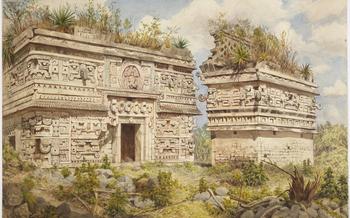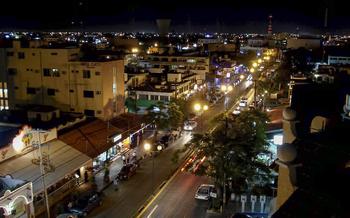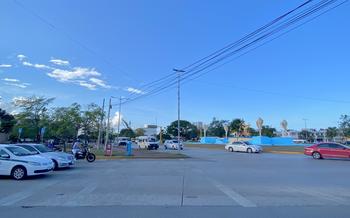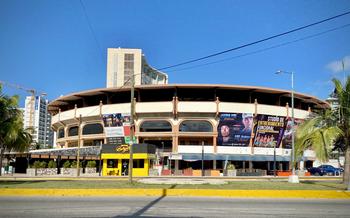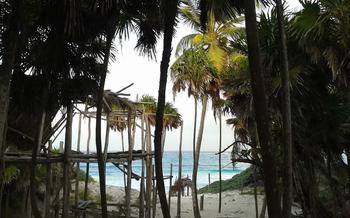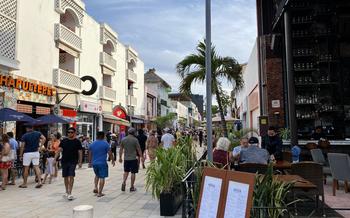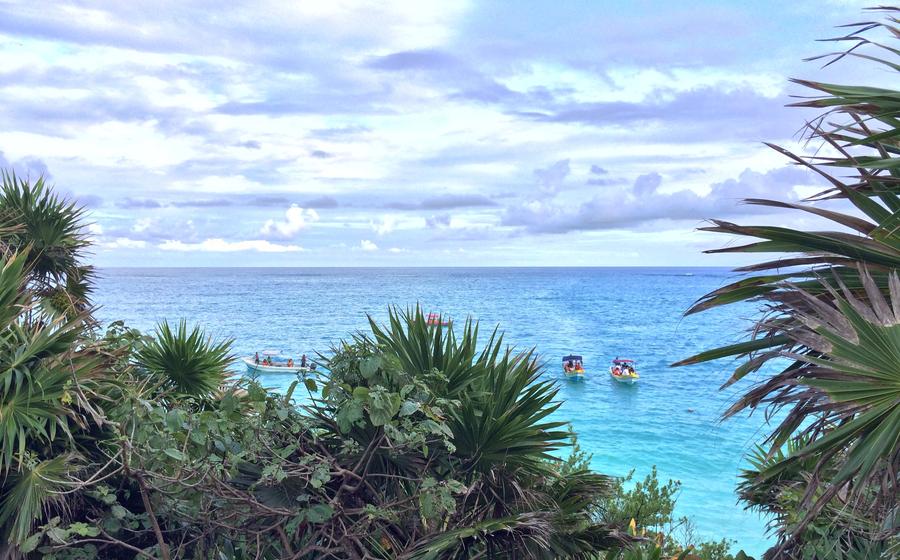
Cenote Naharon (Cenote Cristal)
- History and Significance of Cenote Naharon:
- Getting There
- Entrance Fees and Working Hours:
- Cenote Naharon Facilities
- Swimming and Diving
- Cave Exploration
- Wildlife Spotting:
- Cenote Rituals and Traditions
- Surrounding Attractions
- Sustainable Tourism
- Best Time to Visit
- Photography Tips
- Packing Essentials
- Insider Tip: Unveiling the Hidden Chamber of Cenote Naharon
History and Significance of Cenote Naharon:
The crystalline waters of Cenote Naharon, also known as Cenote Cristal, hold a captivating history and cultural significance that dates back to the ancient Mayan civilization. Once a sacred site for the Mayans, this natural wonder was revered as a source of life and a gateway to the underworld. According to Mayan beliefs, cenotes were believed to be portals to the realm of the gods, where rituals and ceremonies were conducted to honor deities and seek guidance. The cenote's pristine waters were considered sacred, believed to possess healing properties and a connection to the spiritual world.
Geologically, Cenote Naharon is a marvel of nature, formed through the collapse of porous limestone bedrock, revealing a subterranean cavern filled with refreshing, crystal-clear water. The cenote's unique characteristics make it an essential habitat for diverse flora and fauna, including tropical fish, turtles, and various bird species. Its vibrant ecosystem, thriving beneath the earth's surface, adds to the allure of this natural wonder, making it a sanctuary for both wildlife and visitors seeking a connection with nature's wonders.
Getting There
Cenote Naharon is situated just a short distance from Tulum, making it easily accessible for visitors. To reach the cenote, you can opt for various transportation options depending on your preference and budget.
For those who prefer the freedom of exploring at their own pace, renting a car is an excellent choice. The drive from Tulum takes approximately 15-20 minutes, and there is ample parking space available at the cenote.
If you want a more relaxed journey, taxis are readily available in Tulum and can be hired for a reasonable fare. Simply inform the driver that you wish to go to Cenote Naharon, and they will take you directly to the destination.
For those seeking a hassle-free experience, organized tours are a great option. Several tour operators in Tulum offer day trips or half-day excursions to Cenote Naharon, often combined with visits to other nearby attractions. These tours typically include transportation, entrance fees, and sometimes even lunch or snacks, making it a convenient and cost-effective way to explore the cenote.
Entrance Fees and Working Hours:
Visiting Cenote Naharon requires a modest entrance fee, which varies depending on the time of year and any ongoing promotions. Regular rates typically range from $10 to $15 for adults and slightly lower for children. Visitors can take advantage of discounts by purchasing combination tickets that include admission to multiple cenotes or attractions in the area.
The cenote's operating hours are generally from 9 am to 5 pm, providing ample time for visitors to enjoy its wonders. However, it's advisable to plan your visit accordingly to avoid the peak tourist hours. Arriving early in the morning or late in the afternoon can provide a more tranquil experience with fewer crowds. This timing also offers better lighting conditions for photography enthusiasts seeking to capture the cenote's captivating beauty.
Cenote Naharon Facilities
Cenote Naharon offers a range of facilities to enhance the visitor experience. Modern restrooms and changing rooms provide convenience and privacy. For those seeking deeper relaxation, hot showers are available to wash away the day's adventures.
The cenote's management understands the importance of safeguarding personal belongings. Lockers are provided to securely store valuables, ensuring peace of mind while exploring the cenote's depths.
For a convenient and satisfying dining experience, an on-site restaurant offers a variety of local and international dishes. Visitors can savor delicious meals while enjoying the tranquil ambiance of the cenote's surroundings. Whether it's a quick snack or a leisurely lunch, the restaurant caters to every taste.
Insider Tip: For a truly unique dining experience, pack a picnic lunch and savor the flavors of your favorite foods amidst the cenote's natural beauty. Find a secluded spot, spread out your blanket, and enjoy a memorable meal surrounded by the tranquil sounds of nature.
Swimming and Diving
Cenote Naharon provides a refreshing and rejuvenating swimming experience. The water is crystal-clear, allowing for excellent visibility as you explore the depths of the cenote. Designated swimming areas are marked for safety, ensuring a safe and enjoyable experience for all visitors.
For those seeking a more adventurous experience, diving and snorkeling are popular activities at Cenote Naharon. The cenote's clear waters offer exceptional visibility, making it an ideal spot for underwater exploration. Snorkelers can marvel at the diverse marine life, including colorful fish, turtles, and other aquatic creatures.
For those new to diving or snorkeling, rental equipment is available on-site. Experienced divers can explore the cenote's underwater caves and tunnels, home to breathtaking rock formations and unique aquatic life. However, it is crucial to adhere to safety guidelines and dive within your limits, especially if you are not an experienced diver.
Cave Exploration
Beyond swimming and snorkeling, Cenote Naharon offers a unique opportunity for cave exploration. Guided tours led by experienced guides take visitors through the intricate cave systems that connect the cenote. These tours showcase stunning geological formations, including stalactites, stalagmites, and crystalline structures that have been shaped over millions of years.
Safety is paramount during cave exploration, and participants are provided with helmets, headlamps, and life jackets. Guides ensure that visitors follow proper safety protocols, such as staying on designated paths and avoiding touching or disturbing the delicate cave ecosystem.
Cave exploration at Cenote Naharon is a thrilling adventure that allows visitors to discover the hidden depths of this natural wonder. It provides a glimpse into the subterranean world that lies beneath the lush Mayan jungle, offering a truly unforgettable experience for those seeking an off-the-beaten-path adventure.
Wildlife Spotting:
Cenote Naharon is a haven for a diverse array of wildlife, making it a paradise for nature enthusiasts. Swimmers and snorkelers can encounter a variety of fish species, including the vibrant blue-green guapote, the elegant angelfish, and the curious damselfish. Keep an eye out for turtles gracefully gliding through the water, their shells adorned with intricate patterns. The cenote is also home to a variety of bird species, including the melodious songbirds that fill the air with their sweet melodies.
When exploring the cenote, it is important to maintain a respectful distance from the wildlife and avoid disturbing their natural habitat. This will ensure that future generations can continue to enjoy the beauty and diversity of Cenote Naharon's flora and fauna. The cenote provides an exceptional opportunity for nature photography, allowing visitors to capture the vibrant colors and graceful movements of the underwater world. With a keen eye and a bit of patience, you can capture stunning images that will serve as lasting memories of your encounter with this enchanting natural wonder.
Cenote Rituals and Traditions
In ancient Mayan culture, cenotes were considered sacred places, gateways to the underworld, and a source of life and purification. Mayans believed that cenotes were portals to communicate with the gods and performed various rituals and ceremonies within them. These rituals often involved offerings of food, flowers, and other precious objects to appease the gods and seek their blessings.
Some traditional practices associated with cenotes include:
-
Purification ceremonies: Mayans believed that swimming in a cenote could cleanse and purify their bodies and souls. They would often immerse themselves fully in the cenote's waters, seeking spiritual renewal and protection.
-
Rain-making ceremonies: In times of drought, Mayans would perform special rituals at cenotes to invoke the gods and bring rain. These ceremonies involved offerings of food, prayers, and dances to appease the rain god, Chaac.
-
Healing rituals: Cenotes were also believed to possess healing properties. Mayans would often bring sick or injured individuals to cenotes, believing that the cenote's waters could cure their ailments.
Today, while many of these ancient rituals are no longer practiced, cenotes are still revered and respected by local communities. Visitors are encouraged to be mindful of these traditions and customs when exploring cenotes, ensuring their behavior is respectful and does not disturb the sacred nature of these sites.
Surrounding Attractions
Beyond the enchanting allure of Cenote Naharon, Tulum offers a plethora of captivating attractions that beckon adventurous souls. Immerse yourself in the ancient Mayan ruins of Tulum, a testament to the region's rich cultural heritage. Explore the vibrant streets of Tulum town, where colorful murals adorn the walls, and tantalizing culinary delights await at every corner. Bask in the Caribbean sun on the pristine beaches, where powdery white sands meet turquoise waters, inviting you to swim, snorkel, or simply relax and soak up the tranquil atmosphere. Discover the nearby cenotes, each with its unique charm, offering opportunities for swimming, diving, and exploring the hidden depths of the Yucatan Peninsula. With so much to see and do, create an itinerary that allows you to embrace the diverse experiences that Tulum has to offer, ensuring a truly memorable journey.
Sustainable Tourism
Cenote Naharon, like many natural wonders, faces the challenge of balancing tourism with conservation. As responsible travelers, it's crucial to minimize our environmental impact and support sustainable practices to preserve the cenote's pristine beauty for generations to come. Here are some guidelines to follow:
-
Leave No Trace: Avoid littering and dispose of waste properly in designated bins. Respect the natural environment by not picking plants or disturbing wildlife.
-
Use Eco-Friendly Products: Opt for biodegradable sunscreen and insect repellent to protect your skin without harming the delicate ecosystem of the cenote.
-
Support Local Initiatives: Choose tour operators that prioritize sustainability and give back to the community. Look for companies that actively participate in conservation efforts and support local businesses that promote responsible tourism.
Best Time to Visit
Timing is crucial for an optimal experience at Cenote Naharon. The ideal season to visit Tulum and its cenotes is during the shoulder months, typically from April to May and September to October. These months offer pleasant weather with fewer crowds, allowing for a more peaceful and intimate encounter with the cenote's natural beauty.
For the best lighting conditions for photography, aim to visit during the early morning or late afternoon, when the sun's rays create a magical ambiance within the cenote. This timing is also beneficial for wildlife spotting, as many species are most active during these hours.
To avoid the peak tourist season and crowds, consider planning your trip during the week rather than on weekends. This strategy will enhance your chances of having a more serene and enjoyable experience, allowing you to fully appreciate the tranquility and beauty of Cenote Naharon.
Photography Tips
To capture the mesmerizing beauty of Cenote Naharon through photography, consider the following tips:
-
Camera Settings: Opt for a wide-angle lens to capture the vastness of the cenote and its surroundings. Use a low ISO to minimize noise and a small aperture (f/8 or higher) for sharp images.
-
Lighting Conditions: Plan your visit during the golden hours (sunrise or sunset) when the soft, diffused light beautifully illuminates the cenote, creating a magical ambiance.
-
Angles and Composition: Experiment with different angles to create unique perspectives. Position yourself at the water's edge to capture reflections or swim to the center for a stunning underwater shot.
-
Underwater Photography: If you have an underwater camera or housing, don't miss the opportunity to capture the vibrant colors and diverse marine life beneath the surface. Use a flash or natural light for optimal results.
Packing Essentials
When preparing for your trip to Cenote Naharon, it's crucial to pack the right essentials to ensure a comfortable and enjoyable experience.
-
Swimwear: Opt for swimwear that you feel comfortable moving around in, as you'll likely be spending a significant amount of time in the water.
-
Towels: Bring along a large towel for drying off after swimming or diving, as well as a smaller one for wiping off excess water from your face and hands.
-
Sunglasses: The bright Mexican sun can be intense, so sunglasses are a must-have to protect your eyes from harmful UV rays.
-
Sunscreen: Sunscreen is essential for protecting your skin from sunburn, especially when spending prolonged periods outdoors. Choose a broad-spectrum sunscreen with a high SPF rating.
-
Water shoes: Water shoes provide protection for your feet while walking on rough or slippery surfaces around the cenote. They also come in handy for swimming, as they offer better traction and prevent your feet from getting cut on sharp rocks or coral.
-
Underwater camera: If you're an avid photographer or simply want to capture your underwater adventures, consider bringing an underwater camera or a waterproof case for your smartphone. This will allow you to document your swim and capture stunning images of the cenote's vibrant marine life.
-
Waterproof bag: A waterproof bag or dry bag is useful for keeping your belongings, such as your phone, camera, and wallet, safe from water damage while you're swimming or exploring the cenote.
-
Insect repellent: Tulum is known for its lush vegetation, which can attract mosquitoes and other insects. Bring along insect repellent to keep these pests at bay and avoid uncomfortable bites.
Insider Tip: Unveiling the Hidden Chamber of Cenote Naharon
For an unforgettable experience, venture beyond the main chamber of Cenote Naharon and discover its hidden gem – a secluded chamber adorned with stalactites and stalagmites. This secret chamber, accessible through a narrow passageway, offers a glimpse into the cenote's pristine beauty, untouched by the crowds. To fully appreciate the tranquility and serenity of this hidden sanctuary, consider visiting during the early morning hours or on a weekday to avoid the peak tourist influx. Embrace the opportunity to connect with nature and create lasting memories in this magical subterranean realm.
